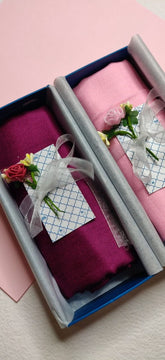Tests to identify real vs fake Pashmina!
The Pashmina marks an aura of opulence and sheer luxury. The royalty and elegance that owning a pashmina provide is unparalleled, making it a clear winner in the fabric world amongst the elites.
The quality of your pashmina is directly proportional to the price one pays for the piece of royalty. But, what if the worst nightmares in a fashion lover's life are brought to life and they manage to get their hands on a fake pashmina? Yes, the market is flooded with counterfeit and fake pashminas.
Put your fears to rest because we, at Omvai, are here to open the gateway to Pashmina heaven. The pashminas at Omvai are pieces of art especially fabricated for the royals.
Before you check out our wide range of handcrafted and finely handcrafted masterpieces, let us check for the indicators to identify a real pashmina.
Pashmina carries certain properties that can help you identify a genuine fabric. Before you spend the big bucks on buying that beautiful pashmina, here are some things to keep in mind:
Does it remind you of butter?
This is the first and the easiest way to check the purity of your Cashmere. Owing to the fine diameter of the fiber, a pure Pashmina should feel extremely soft and smooth against your skin! A genuine pashmina will never cause any allergic reaction. In case your luxury wrap itches once you wear it, run!
All that glitters isn’t always gold!
Unfortunately, glitterati is not a positive sign when talking about a Pashmina. The fabric does not have any shimmer of its own. The only way a Pashmina can shine is if another fabric, maybe silk, has been blended with it. Another easy way to save yourself from buying duplicates!
Light coming through? It’s a sign
A sign that the seller is trying to fool you into buying a fake pashmina. Genuine pashmina is never transparent. Simply hold your luxury wrap under the light. You can gauge the genuineness of the pashmina when the fabric is opaque without radiating any light.
Read between the lines (of the label)
A genuine wrap is most likely to be accompanied by a label screaming its authenticity. But sometimes labels can be deceiving too, right? To rule out the concern of a fake label, we have the ‘glue test’. If the label or tag has been glued to the pashmina, ensure that you ditch the piece. A genuine Pashmina cannot hold the glue for long and requires that the label be stitched to the fabric.
Irregularities are good, sometimes!
Genuine pashmina is not even. Cashmere wool is very delicate, suitable only to be spun by hand. The artisans are tirelessly putting in the effort to present you with a piece that will leave you awestruck. Even the finest Pashminas will display irregularities. If one is looking for evenness, it is a call for trouble, since only machine-made or mixed-blend products can deliver consistency. The weave of your Pashmina should be uneven.
Ply, Dimensions and Diameter
These are the technical ways to check for the quality of your elite fabric for the pro in you. The fibers in the authentic pashmina will be around 15-19 microns in diameter. The lower microns in diameter are responsible for making the Pashmina lighter and warmer.
This is inversely true for ply and dimensions. A higher dimension indicates a better quality of fabric. Ply is the number of strands used when weaving the fabric together. A higher ply will make the fabric thicker, thus making it pricier.
Pilling is Unavoidable
An animal fiber can never be bereft of pilling. No pilling is a sure sign of a synthetic product. A genuine animal fiber, Pashmina is very likely to pill, no matter what.
The Rub Test
Don’t shy away from rubbing the fabric! It is universal knowledge that polyester and synthetic fabrics generate static when rubbed against something. This is not true in the case of a genuine pashmina. To get an understanding of the purity of the animal fiber, perform the rub test on your soft, rich Pashmina!
The Burn Test
Remember to activate your sense of smell before this step!
We apologize in advance for asking you to perform this brutal act, we understand it is difficult. But you only need the tiniest piece of thread from the fringes of your Pashmina wrap. It will suffice for performing the steps of the burn test, promise! Simply place the thread on a ceramic or steel pot without covering it and light the match while letting your thread burn. Smell it. We hope you don’t smell plastic!
Does it give off a burnt smell? If yes, congratulations on procuring a genuine piece of the luxurious heaven. Cashmere and pashmina are made out of natural hair, resulting in giving you the experience of smelling burnt hair.
Phew! We hope that it was not a close call. These are fail-proof methods of distinguishing your Pashmina from a fake fabric.

